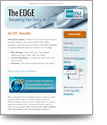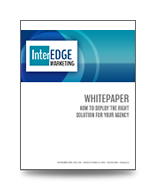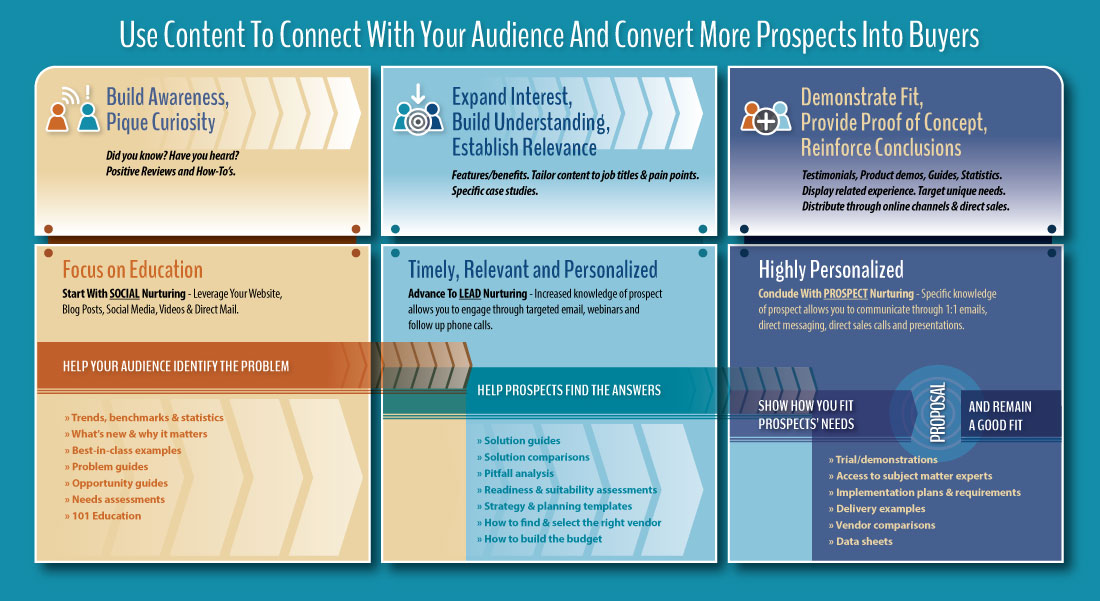
The customer journey. It’s how potential prospects and current customers interact with you and your company. When you deliver continuous value throughout that journey, you'll connect with more prospects and add more customers. But when the customer journey gets derailed or hits a dead end, you miss out.
Connect with more prospects as they progress through the buying stages. Here's how.
The Customer Journey Progresses Through Stages
A B2B sale is rarely an impulse purchase. Instead, the customer journey progresses through stages and often takes months or longer to lead to a purchase decision.
Discover → Compare → Consider → Commit → Retain
- Discover - Make the case
- Compare - Stand out
- Consider - Win out
- Commit - Contract signed
- Retain - Partner happy
However, an effective web strategy can impact these stages, increasing the number of prospects that discover and compare your capabilities.
How Discovery And Compare Occurred Before The Internet
Customer journey steps haven't changed throughout the years. But, how prospects access information today make the process very different.
Discovery
Although prospects accessed trade magazines, association information, attended trade shows and more, B2B companies used their sale force to foster discovery.
It started with “prospecting.” Before LinkedIn or other data sources, reps went from account to account to get names of prospects and attempt to schedule a meeting. If the rep was lucky, the buyer met right then and there. But if not, the sales rep dropped off a brochure and attempted to schedule a time to discuss his or her capabilities. For B2B companies, the customer journey discovery step started with these interactions. Prospecting was a key element to discovery before the internet.
Compare
If you were able to schedule a meeting you could gain a better understanding of how the customer operated, the vendors they were using and any problems the prospect was experiencing. Perhaps these discussions took place over lunch. This helped you to build a relationship all while positioning your capabilities as a viable alternative to their current process. If your products were new or unique, it allowed a prospect to compare their current system with the one you were proposing.
How Discovery And Compare Take Place Today
Not surprisingly, things are different today. The web changed how we buy and sell. And from a customer journey perspective, how a prospect progresses through the discovery and compare steps changed most significantly. Although it’s still possible to connect with a prospect and personally guide them through each step of the journey, it’s far more likely that at least the discovery and compare steps occur online.
To maximize your success, you must identify and optimize the online resources that connect with the customer journey. Here’s why:
- 54% of B2B buyers begin their buying process with informal research about business problems; nearly 80% of the time spent researching is done online. Forrester
- 94% of business buyers do some form of online research Acquity Group
- 84.3% check business websites
- 48% of people cited a website’s design as the number one factor in deciding the credibility of the business. Smart Insights
- 94% of people cited web design as the reason they mistrusted or rejected a website.
Connecting With Your Customer’s Journey
Without the basics - an effective website with useful content - you will disconnect from the customer journey. So how do you reconnect?
The best way to understand how a prospect interacts with you is to develop a customer journey map. A diagram that illustrates the steps your customers go through in engaging with your company.
Start by identifying your ideal customers and determine.
- How you have successfully connected with them in the past
- Typical concerns they have at each stage of the journey
- Information required to address these concerns
- The best tactics to deliver this information and connect with these prospects
- Educate and increase awareness
- Elevate your company to the viable option category
|
|
Understanding the touch points and developing strategies that link with prospects as they advance through the decision making process make it more likely they'll progress to the next stage. And when you connect at each stage of the customer journey, you increase the odds that more prospects turn into paying customers!
Need Help Defining Your Web Strategy? Contact us Today!


 Insight Delivered Directly to You Interesting topics, great offers and free marketing tools.
Insight Delivered Directly to You Interesting topics, great offers and free marketing tools.

